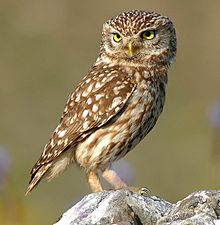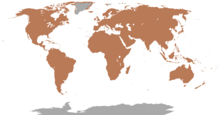Owl
Owls are birds in the order Strigiformes. There are 200 species, and they are all animals of prey. Most of them are solitary and nocturnal; in fact, they are the only large group of birds which hunt at night. Owls are specialists night-time hunters. They feed on small mammals such as rodents, insects, and other birds, and a few species like to eat fish as well.
| Owl | |
|---|---|

| |
| Little owl (Athene noctua) | |
| Otus jolandae call | |
| Scientific classification | |
| Domain: | Eukaryota |
| Kingdom: | Animalia |
| Phylum: | Chordata |
| Class: | Aves |
| Clade: | Afroaves |
| Order: | Strigiformes Wagler, 1830 |
| Families | |
|
Strigidae | |

| |
| Range of the owl, all species. | |
| Synonyms | |
|
Strigidae sensu Sibley & Ahlquist | |



As a group, owls are very successful. They are found in all parts of the world except Antarctica, most of Greenland, and some small islands.
Owl families
changeThere are two families of owls: the true owls and the barn owls:
Appearance
changeAn owl has a big head, flat face, hooked beak, short tail, and sharp talons, The wings of an owl are long. Owls have brown, gray, or white plumage with streaks or spots.
Adaptations
changeOwls have a suite of adaptations which help them to be successful.
Owls have large eyes and holes for ears, a hawk-like beak, and a rather flat face. Most birds of prey have eyes on the sides of their heads, but the owl's eyes are facing forwards to help it see better in the dark. Their eyes are also fixed inside their sockets, so they have to turn their whole head to look at other things. Owls can rotate their heads and necks up to 270 degrees in both directions.[1][2][3]
Owls are good at looking at things far from its eyes, but it cannot see anything clearly within a few centimeters of their eyes. Owls use small feathers on the beak and the feet that help it feel the prey it catches.
Hunting
changeMost owls hunt at night, and in twilight (dawn and dusk). A few owls are also active during the day.
The owls' hunting depends on surprising its prey. Their most important adaptation is their almost silent flight. The feathers are soft, with fringes on the back edge, and the base of each is downy. This all muffles noise, and makes for silence. Also, they glide when coming in for the kill.
The dull colors of the owls' feathers make them less visible by camouflaging the owl. This helps them as they roost during the day.
Owls have fantastic hearing. The shape of the head helps slight sounds reach the ears. The feathers of the facial disc are arranged in order to increase sound delivered to the ears. Their ears are asymmetrical allowing the owl to locate a sound. They can hear a mouse move in the grass.
An owl's sharp beak and powerful talons allow it to kill its prey before swallowing it whole, unless it is too big. Owls usually regurgitate the parts of their prey that they cannot digest. These parts include bones, scales, and fur. Scientists who study the things that owls eat can get clues by studying the parts that the owl spit back out, called "owl pellets". These "owl pellets" are sold by supply companies to schools for use in the students' biology and ecology lessons.[4]
Winter larder
changeMany animals store food during times of plenty to prepare for leaner times. Owls may store dead mice for winter.[5]
Swivelling the head
changeOwls have special adaptations which help them swivel their heads 270 degrees. They have 14 neck vertebrae instead of our seven. Also, the big carotid arteries, instead of being on the side of the neck as in humans, are carried close to the centre of rotation just in front of the spine. So these arteries get much less twisting and stretching, and the potential for damage is greatly reduced. This arrangement is seen in other birds, but in owls the vertebral arteries – the vessels that travel through channels in the neck bones – are given extra space.[6]
Owls also have wide parts in their carotid arteries just under the base of the skull. Researchers found these could dilate and fill with a reservoir of blood. "We believe this is kind of a new structure not really known before", said a researcher. "It's probably a way to pool blood and get some continuity of flow even if there is disruption below at the next level".[6]
Owls in culture
changeMythology and stories that include owls are:
- The owl is the symbol of the Greek goddess Athena (Minerva to the Romans)
- Nursery rhyme: "The wise old owl sat in an oak, the more he heard, the less he spoke".
- Poem by Tennyson: "The wise owl in the belfry sits..."
- "Wol" is a character from the Winnie the Pooh books by A.A. Milne.
- Owls carry the mail in the Harry Potter books by J.K. Rowling.
- Owls are featured in the book series Guardians of Ga'hoole by Kathryn Lasky with most of the series' characters being owls.
Gallery
change-
An eagle owl is a very large owl. This is a barred Eagle owl from Ubud, Bali, Indonesia.
-
This scops owl in a tree, Africa, shows how the spotted feathers camouflage the owl during the day time
-
This masked owl from Australia shows the circle of feathers around the eyes.
-
Some owls like this striped owl from Japan have feather "tufts" that look like ears.
-
This snowy owl is waiting to see or hear a movement.
-
The owl has swooped down and is seizing its prey in its talons.
-
Owl pellets can tell a lot about the habits of an owl.
-
This owl pellet was taken apart. It contained teeth, bones and fur of small animals.
Related pages
changeReferences
change- ↑ "San Diego Zoo Birds: Owl". San Diego Zoo. Retrieved 2010-08-24.
- ↑ "A Parliament of Owls". Colorado Division of Wildlife. Archived from the original on 2011-01-16. Retrieved 2010-08-24.
- ↑ "The Owls of Big Bend". National Park Service U.S. Department of the Interior. Retrieved 2010-08-24.
- ↑ ""Owl pellets in the classroom: safety uidelines"". Archived from the original on 2010-06-03. Retrieved 2010-11-14.
- ↑ Falcons imprison live birds to keep them fresh for a later meal. New Scientist. [1]
- ↑ 6.0 6.1 Amos, Jonathan 2013. BBC News Science & Environment. [2] How owls swivel their heads
Other websites
change- Facts about Owls Archived 2011-04-19 at the Wayback Machine